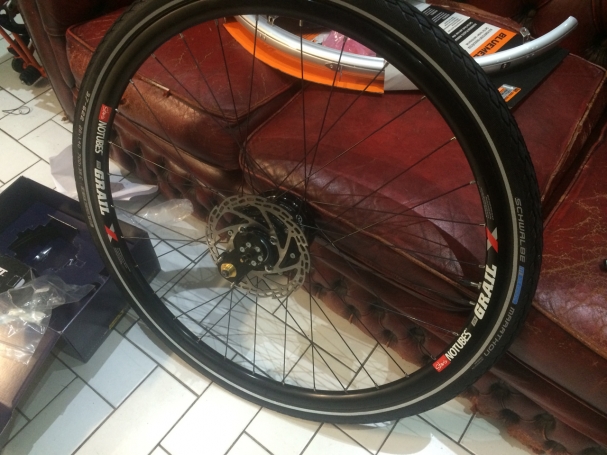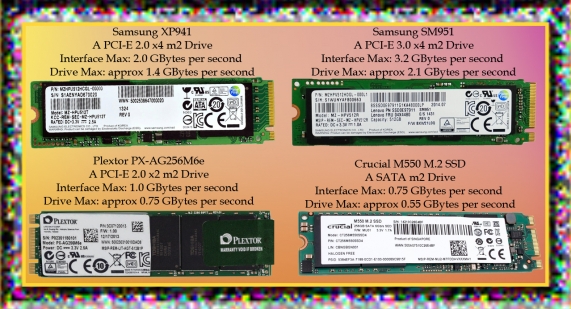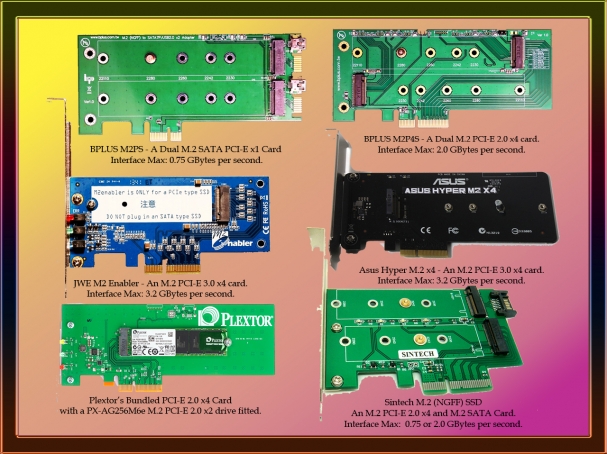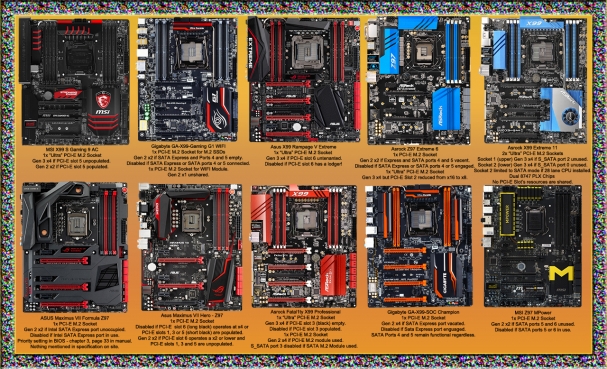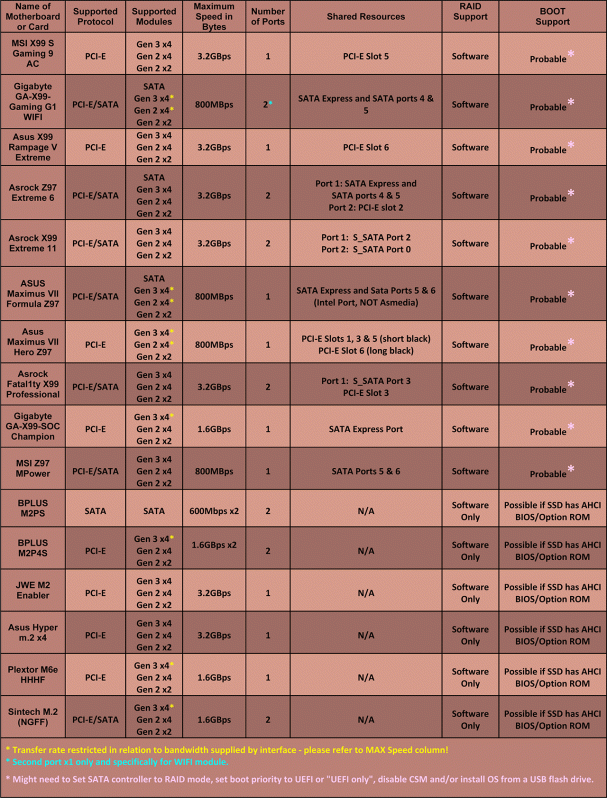M.2. Please Just Standardize
With 2013 witnessing the phase out of mSATA, and introduction of several novel standards of progressively diminutive SSD hardware emerging here is a very small retrospective interpretation on how baffling things were if not for anybody else aid then for my own peace of mind.
Here is an mSata drive.
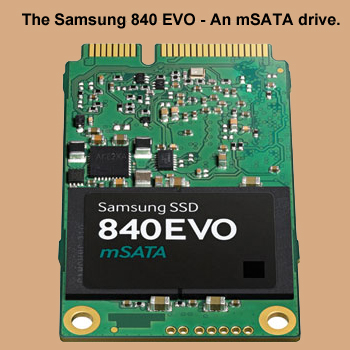
Essentially, the innards of a generic SSD, a device launched in 2009 and typically installed in laptops by vendors or adventurous hobbyists to conserve space with no performance penalty when compared to regular SATA SSDs.
Fast forward approximately three years to a thriving desktop wonderland of ultra speedy USB the third, scorching SATA 6G, oceans of PCI bandwidth and UEFI bioses with Mensa IQs and leading motherboard moulders began building accommodation to support these drives into their proud creations.
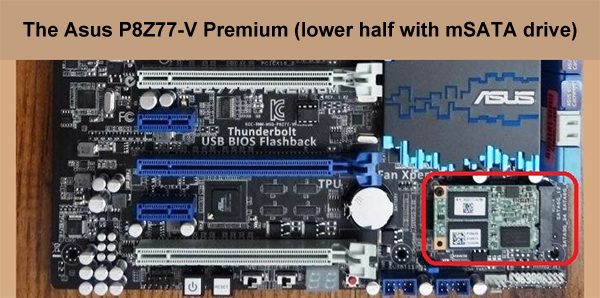
Thus, the cumbersome desktop could reap rich spoils. A super swift super slim boot device, a drive especially reserved for voluminous virtual RAM or a quick and quiet caching solution for larger, mechanical hard drives.
No sooner had interest spread amongst early adopters, then the inevitable powers that were grew board and saw fit to revisit their blueprints. Inside a conference room flooded with false daylight and beautifully appointed with a magnificent showcase of Charles Eames counterfeits, bouts of impassioned brainstorming invoked momentous and judicious evolution. Amendments to height and width were promptly imposed as was the inspired decision to produce drives of varying lengths, in order to enhance potential capacity. The M.2 standard was upon us.
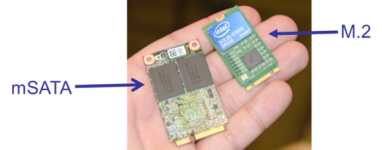
—————————————————————————————————–
M. 2 (NGFF) – Next generation form factor.
The revised connector was also conceived to trigger a titanic boost in performance, by permitting data to travel directly over the PCI-E bus instead of the comparatively bandwidth starved SATA bus, though in order to accomplish this, new drives were also needed.
Initially, as with any technological quantum leap, these highly advanced, resource concious devices were scarce and horribly expensive when compared to their mSATA ancestors. Thus, in order to quickly establish a healthy customer base for the fledgling design, those older siblings were hastily reincarnated in accordance with the same architectural parameters.
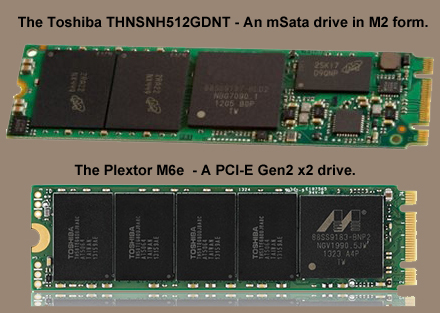
In brief, the one above, M2 Sata utilized the SATA bus to ferry data and supported speeds of close to 6 Gigabits per second (the bus’s bandwidth limit).
The one below, M2 PCi-E Gen 2 x2, occupied two PCI-E express lanes to over which to send and receive and hence, attained speeds of over 6 Gigbits per second, whilst the actual interface allowed for up to 10 gigabits per second. Their connectors however, were identical, each with two notches (known as M and B keys).
To complicate vastly complicated matters, a third type of drive was soon to arrive on the scene, M2 PCI-E Gen 2 x4.
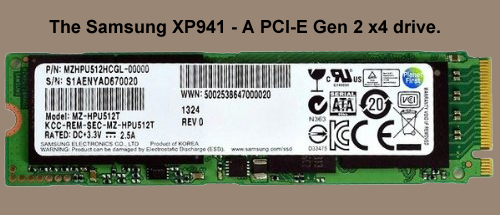
The fleetest of all so far, these drives again were wholly dependant on the PCI-E bus for their data exchanges but used four lanes instead of two, doubling the available bandwidth and raising potential speeds to 20 gigabits per second. They sported a slightly different connector with only one notch, the M key present, the B key being replaced with two contacts, allowing access to the additional PCI-E lanes.
To summarize:
M.2 Sata = M and B Keys
M.2 PCi-E Gen 2 x2 = M and B Keys
M.2 PCI-E Gen 2 x4 = Only M Key.
As if this weren’t enough to vigorously scramble the poor customer’s grey matter, manufacturers frequently chose to electrically wire the sockets on their products to operate with just one of these three devices. Sometimes, it would be Sata only, as was the case with the adapter below:
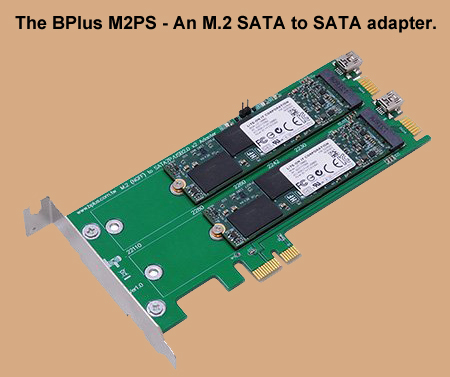
This meant such drives as the Plextor M6e (a PCI-E 2.0 x2 based M.2 drive) would not be recognized but the Toshiba THNSNH512GDNT THNSNH512GDNT (a SATA based M.2 drive) were detected, despite both being physically compatible with the slots.
In other instances, the reverse was true.
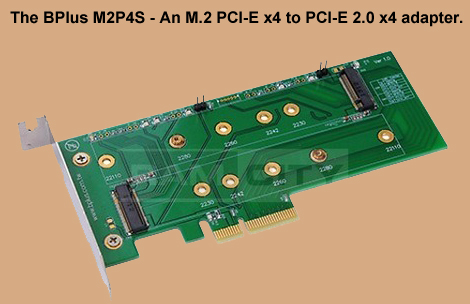
The card above could be paired up with PCI-E 2.0 M.2 drives such as the Samsung XP941 and the Plextor but offered no support for SATA propelled M.2s like Toshiba.
In the case of M.2 Sata modules, the M key was only present to enable their installation in PCI-E M.2 sockets, assuming, of course, these had been connected to the motherboard’s SATA controller.
Numerous sites, including several hosted by e-tailers actively selling the product, claimed that it could only identify PCI-E modules with the B key removed and all four lanes accessible and that x2 devices incorporating both keys failed to function. In practice, this was utter nonsense, as was evidenced by the following insightful analysis on Custom Pc Review.
It’s one thing when bemusement reigns as a result of diverse experiences amongst consumers and reviewers but when manufacturers themselves appear incapable of divulging accurate specifications, what bloody hope is there?
Eventually and one might hope, mercifully. Certain OEMs began to combine the practical with the profitable.
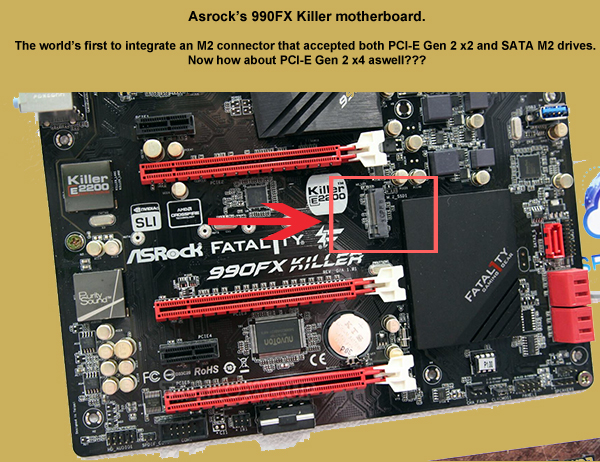
And Finally…
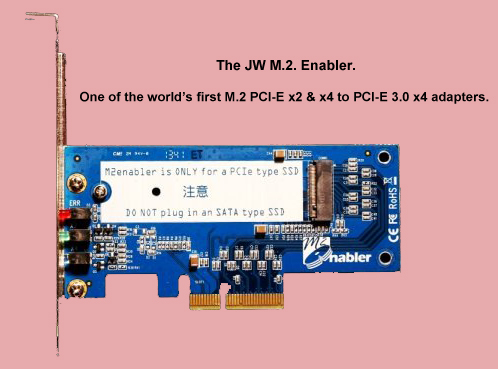
The JW M.2 Enabler was a PCI-e 3.0 x4 card and supposedly supported all available types of PCI-E M2 SSDs – Gen 2 x2 like the Plextor M6e and Gen 2 x4 like the Samsung XP941.
Moreover, being a 3rd generation PCI-E device, it supplied the installed drive with enough liberal lashings of bandwidth to reach speeds of almost 40 gigabits per second, a fitting future proof solution to an infuriatingly complex past. Such a shame that it was impossible to purchase and didn’t support SATA M2! But wait…there was yet more.
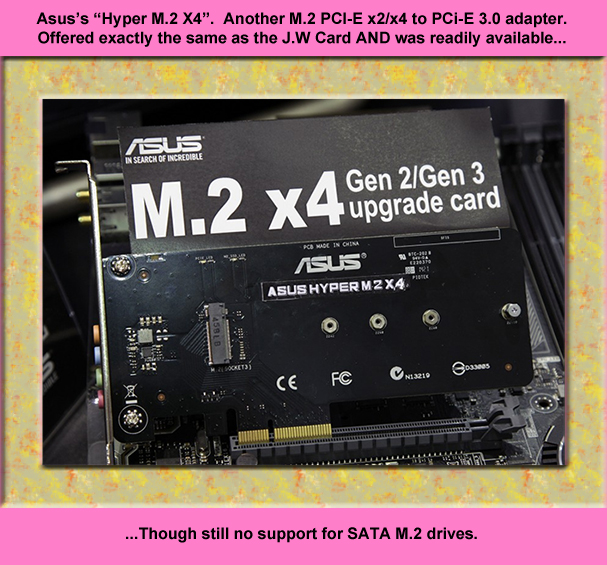
So, to cap this dastardly disk dashing farce once and for all…
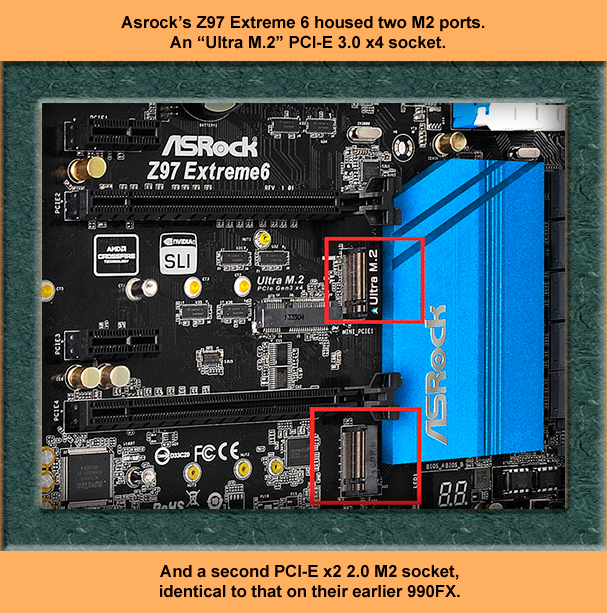
Asrock’s solution was to furnish their upper-mainstream instrument of maternity with two separate M.2 ports.
The first, an “ultra M.2” port was allocated four PCI Express 3.0 lanes directly from the CPU, thus eluding any chipset latency and bestowing the same bandwidth as the Asus and JW cards (almost 40GBPS) to any existing and future PCI-E x4 M2 drives. The Second M2 socket (a PCI Express 2.0 x2) was a replica of that on the company’s 990FX “killer” board mentioned above.
Incredibly and at long last, this port would allow all the drives discussed (the Toshiba, Plextor AND Samsung) to be recognised by the system, though any x4 drive (those with the single “M” Key) would be limited to a speed of 10 GBPS, the maximum granted by two second generation PCI Express lanes.
The above may well be added to as history continues to germinate, though what is written already surely illustrates the hazards encountered by the early adopter and makes manifest the terrifying consequences of committees, exhibitions and an irrational fear of simplicity.
Well, you can’t claim you were warned.
A few months rolled by, taking their toll on my tolerance for Christmases adorned in horizons of frigid and dour grey, and it was January 2015.
I had rigorously resisted any reckless “seasonal” investments” by virtue of a magnificent and reliable studio with which I was eminently satisfied. That and old age not to mention a growing terror of drastic change combined, with a stubborn disinterest in taking hours to heed supposedly educated technical teachings and learning of nothing save for the criminally confused state of technology. Notwithstanding all that, I felt that to voluntarily lose touch with trends would be to let my work ethic wander and ignore a mantra that expels life’s daemons, “Progress is Never Painless”.
Eventually, I summoned the courage to resurvey a range of topics covered throughout the short past, in agitated expectancy that a solitary applicable committee, corporation or manufacturer had striven to quell the bewildered customer’s grievous quandaries.
First up, NGFF, yet another superfluous abbreviation for this stupefying storage medium of which, after hours of scouring for the tiniest scrap of certainty, I was utterly sick.
As I write in the small hours of a silent, star lit January dawn, there is little worth adding to the last three pages. Some kind of informal open ended summary might prove constructive. How about a carefully coordinated table. One to casually fill in as M.2. morphs maddeningly into more manifestations than a chameleon with multiple creature syndrome stuck in a hall of mirrors, before descending into a devastating maelstrom of data curdling confusion and being indignantly usurped by something every bit conscious boffin agrees is “faster and generally better all round really”.
Since all my attempts to clarify led me to a vile vortex heaving with hexadecimal obscurity, you’ll have to consider the notes below to be strictly contextual and my humblest apologies to any kind visitors that have read or worse, acted upon subsequently erroneous assertions.
Some Rules of Thumb for the Thumb Sized.
In the precursory part of this procrastination I was curious to ascertain whether any readily obtainable expansion cards delivered a working environment for NGFF’s complete cast of subtle variants. M2 Sata, M.2 Pci-e 2.0 x2, M.2 PCI-E 2.0 x4 and the future revision, M.2 PCI-E 3.0 x4.
After embarking on an woeful wander across the web, I returned with no solution and a permanent squint, though a handful of forums along the way had unearthed many a morose storage hunter who harboured the same aggravated need for standardization.
Following the arrival of the z-97 and x99, a double helping of the crispiest chunkiest chips, fresh from the Intel’s formidable fryer, M.2 was no longer a lucky extra, mindful afterthought or a luxury limited to those with enough space and sovereigns for cumbersome pci appendages. It was an intrinsic element in both designs and showed all signs of long term tenancy amidst a motherboard’s solder.
The Z-97 was the Intel’s first silicone ensemble that permitted it’s licensees to integrate NGFF by default. If the M.2 socket used two PCI-E 2.0 lanes from the PCH (Southbridge) it could serve as dual purpose quarters for M.2 PCI-E and M.2 Sata moulded modules, but only if the manufacturer either chose, had the option or been considerate enough to configure it to communicate over both the PCI-E and Sata buses, as was the case Asrock’s aforementioned 990FX Killer and z97 Extreme 6.
The X99, in many of its rich and varied realisations, appeared to represent a concerted effort by licencees to economize on production by phasing out M.2 Sata altogether. In fairness, the majority might have acted on the assumption that any user opting to recruit the Haswell-E platform would be loathed to waive velocity for value, especially when presented with a greater quantity of conventional SATA ports than on many dedicated RAID controllers, coupled with the prospect of another PCI-E centric invention, SATA Express.
Bearing in mind such unfounded theories and the fruitlessness of my previous quests, I decided to focus on some of the latest marvels of maternal engineering and vowed to remorselessly investigate;
A: The veracity behind their founding vendors’ perpetual propaganda.
B: Whether any embodied this elusive skeleton socket.
The importance of B cannot be overstated and relates to any business with a turnover, no matter how modest or magnificent. False, misleading, irresponsible and exploitative, are are just four advertising methods frequently employed by emphatically praised promotional experts and avidly admired marketing departments, though in this context, such acclamation and reverence doesn’t originate from consumers, especially those pitifully clinging onto pathetic concepts like post sales support, or counting on kinder attention from a call centre than their own credit cards received on the day of purchase.
Instead, it comes at a grudge, from rival profiteers who then proceed to imitate and improvise on the treacherous tactics of these morally destitute role models, resulting in severe and cyclical collateral damage to their customer base. What on earth was that? A long winded and excessively hostile rant of questionable relevance? I suppose it could have been shorn of several syllables, but the portions of aggression and pertinence were as proper as Jeeves serving Bollinger to royalty. Let’s find out why.
When frequenting ornate on-line showcases of the modern computer’s most prolific component proponents, rabble rousing eulogies preaching a product’s radical features are as inevitable as their subsequent denouncement as “ground breaking” gimmickry.
It would be unsporting to deny players in such an acutely competitive industry any margin for “slick” marketing. Selective editing to accentuate major selling points and expound on unique innovations should not only be spared reproach but permitted reasonable defence on the premise that a buyer possesses basic literary skills, has carried out respectable research comparing the key aspects of several items produced for similar or identical purposes and ultimately, is able to make a free, educated choice founded on prudent practicality or the fiery, irrational desire for patented prettiness.
However, when shortcomings are secluded by obfuscation, omissions and oversights, all too convenient to be excused by typos, memory lapses or Master Asus expounding so extensively on the ingenuity of his hyper intelligent fan management system that he neglects to mention it’s post ventilation wellness program for fans struck down by pernicious particle induced rotational psychosis – otherwise known as dust – only includes stress counselling for those with rifle and sleeve bearings…
Master Asus: I’m planning one for ball and fluid bearings, but since their burn out rate is lower they require less revolutionary treatment.
Customer: Not good enough, I have four nauseous Noctua’s here, all oil bearing PWMs, delusional and steadfastly refusing to swirl for a board you sold me unless they are suitably rehabilitated. They’ve been on relentless duty cycle for five hard years, don’t tell me they don’t qualify.
Master Asus: Woah! Indirectly sold to you. Did you read the details off your e-tailer’s site rather than my own, some things do wander in translation. I know I mentioned fans with endemic weaknesses would be given priority….
Customer: All fans have bearings and some are susceptible to PPIRP. So what? That’s just the way were bred, for the frugally inclined. How in your universe does that constitute an inherent illness and where do you say it? I see no such claim.
Master Asus: Just below the section about Multi-Zone Specific Superfine Granularity Thermal Calibration”.
Customer: No, still nothing, save for your promise that “long spinning fans will be thoroughly analysed in strict compliance with the guidelines for structural and circulatory stability and any job related injury or disorder or will benefit from immediate and appropriate care pursuant to their individual case history.”
Master Asus: Ah!, you’re looking on my “overview” page, not the “specification” page.
Customer: Pardon me?
Master Asus: Look across the top of the page you’re on and you’ll see a tab marked “specification”. Click on it once and you’ll be able to view your motherboard’s unabridged portfolio, including the relevant disclaimer, plus dozens of additional footnotes at the very bottom marked out by stars and numbers. You might need to enlarge your font a tad, just to make them legible, but all that needs to be mentioned is present there, of that I can assure you.
You see, this was when sporting and stimulating promotion mutated into premeditated deception. A bullish and bedazzling pitch to the mentally pliant, saturated with florescent logos, fancifully interpreting innumerable brand decorated bonuses and smothered in enough flash to make your browser falter.
Then, loitering just out of an engrossed eye’s glimpse, behind a link even less conspicuous than a bright Pink Elephant tooting Mozart’s horn concerto…at a the annual “Monstrously Musical Quaintly Coloured Herbivore’s Convention”, a lengthy but similarly low key statistical appendix teeming with allusions to befuddling operational anomalies that compromise many of the product’s most alluring assets. For Instance:
Slots whose broadest bandwidth depended on several other functional forfeits
Sockets and ports that couldn’t be used simultaneously…unless a slot was vacated, a particular CPU installed and the devices wishing to employ them bore officially validated international data transport licences.
Hardly conducive to retaining a consumer’s trust and ensuring their long term satisfaction. Should we afford friends the same attitude? Would I, on a classy, cordial and tastefully oiled evening “graciously” offer to cover for several rounds of exotic and exorbitant cocktails, collect the tab in apparent good grace, then casually produce a carrier back loaded with 3600 five penny pieces – approximately 4540 nickels – before claiming, in an clinically rehearsed tone of regret, that by staggering misfortune and mysterious coincidence, every teller at you local bank was spontaneously struck down with an acute phobia of paper currency and large change.
My Conscience: Hmm. Wouldn’t a carrier bag burst under the strain of all that coinage? How did you get it from the bank to the bar?
Me: Oh. Alright, a suitcase then.
My Conscience: That you produced at the end of the evening? You must have had it all the time then, it couldn’t have just magically appeared after picking up the tab.
Me: That’s correct.
My Conscience: Wouldn’t your friends have found it slightly odd. You lugging around a weighty suitcase on a social evening out. Didn’t any of them think to ask, “Goodness what’s in there?”
Me: Ok, it was one of those light canvas fold up bags, the type you can fit in your pocket..
My Conscience: Not with 3600 five penny pieces you couldn’t.
Me: No, I left home with it empty, then went to the bank after agreeing to pay for the rounds
My Conscience: Hmm. What time did you meet at the bar?
Me: About seven thirty, perhaps eight.
My Conscience: Banks stay open quite late in your vicinity then?
Me: God almighty, is this an inquisition? It was only simple analogy, I agree it was ill-thought out, let’s just forget it.
My Conscience: Sorry, I can’t let you carry on without resolving these logic errors.
Me: Fine. I went to the bank with the bag at 3pm and asked to withdraw £150 in five penny pieces. The clerk was slightly confused to begin with, and didn’t know if the bank could even arrange such a transaction. I told her it was very important and intended for an artistic installation at a small charity funded exhibition to raise awareness of the national debt. After sympathizing and checking with the branch supervisor, she said it would be ok. I left the bank at 3:30 with 3600 five pees in the bag and walked home.
My Conscience: Walked all the way with that bag.
Me: I live quite close to the bank.
My Conscience: Do you know what the weight of a 5p piece is
Me: 3 grams.
My Conscience: Ah! You went to the trouble to verify that one eh? So 3600 times 3 is 10800, there’s your weight in grams, divide by 1000 and we’ve got 10.8 kilos, about the weight of a Scotty Dog, plausible enough, continue.
Me: I left home with the bag at 7:15pm and arrived at the bar at just after 7:30, it was actually more like a restaurant with a separate bar and had a cloakroom nearby where you could leave coats and luggage
My Conscience: Very clever
Me: I met up with my friends in the bar fifteen minutes later. Now, please be satisfied and go away.
My Conscience: How many friends
Me: Seven, including me.
My Conscience: How many rounds of Cocktails.
Me: Four
My Conscience: Hmm, five pounds per cocktail, were they selling them regurgitated?
Me: ALRIGHT!!! Five friends, including me and four rounds.
My Conscience: That’s £7.50 per cocktail, sounds bang on. So you did all this in order to appear generous, but came across more than a little eccentric.
Me: To get out of paying whilst being perceived as selfless and able to back it up with hard evidence. You see the maximum amount payable in 5 penny pieces is £5, the bar would have refused to accept my funds and a friend would have bailed me out.
My Conscience: So, they all believed your story about the bank staff’s fear of paper money high value coins?
Me: Yes, because the cocktails made them pleasantly gullible and they weren’t the brightest bunch besides and no, none of them remembered the next day. Now, LEAVE ME ALONE!.
I’m exhausted. Time to sail with the winds atop a prevalent tide on a welcome return journey to the principal point…what the hell was it?
M.2 sockets and their modular versatility.
I detest dwelling on dates but for the sake of accurate assistance to any future forum furore liable to rely on the meanderings above, below, left or right, it’s probably best I should mention it was 20:32 on the 14th of the 1st of 2015 when these characters emerged on an arcane IPS panel and any relevance they have since lost is the sole responsibility of the readers and researchers. Aren’t you glad I didn’t divulge that disclaimer in a font visible to nothing but a Harris Hawk with bifocals hovering behind the Hubble Space Telescope.
Firstly, let’s re-establish why no card based vessel, not least those hitherto inspected, was able to receive and initialize every member of M.2’s feisty foursome and furthermore, acquaint ourselves with these blazingly brisk but exhaustively enigmatic digital archivists.
We’ve already been introduced to the Plextor and precious little has altered. A PCI-E SSD that will strive its hardest to please in a socket that allocates it two lanes of second tier bandwidth 2.0.
The Crucial Stick (CT256M550SSD4) replaces the SATA equipped Toshiba (THNSNH512GDNT), familiar to those who partook in past paragraphs. My reasons for a substitution this late in the game are justified, as shall become apparent before too long. Like the Toshiba, all its transfers were conducted over the SATA bus at a comparatively measured pace. It’s measurements and notches are indistinguishable from the Plextor’s with both the “M” and “B” keys present and each could inhabit the the same type of socket.
I hasten to add at this juncture that as of April 2014, virtually the stone age, no M.2 connectors, be they on motherboards or expansion cards, had pins “populated” or “blocked off” in both the M and B key positions.
Just in case you’ve forgotten, because I certainly have, the B key by itself defined a SATA destined M.2. A solitary M key showed the SSD was built to supply a stunning four course “express” service and lastly, M and B keys together keys meant the module was either SATA or PCI-E based, but with the opposing key added to enable compatibility with dual purpose hosts. In this instance a PCI-E drive would be restricted to two lane communication owing to its missing “B key” contacts.
For reference, I have never once glimpsed an m2 SSD or socket with only the B key cut or corresponding pins purged and can only theorize that if they ever existed, it would have been during the interface’s earliest stages of development.
Suffice it to say that every SSD and slot we’ll be examining hereafter is physically interchangeable, making things encouragingly simple and repugnantly complex. You’ll find out why.
Samsung’s XP941 is another well schooled campaigner who has enjoyed a credible reign as M2s grand master. Depending on its host, always assuming they could spare four lanes to field its sustenance, it could shift 1.4 Gigbytes of a user’s digitized life laundry per second.
Lastly, a début of historic significance and perhaps the most sensationalised solid state sequel ever to enter the ranks of rapid binary transference. For months, fraternities of Flash philanders had lustfully speculated over the merits these byte sized data wafers would draw from PCI-E’s third and supremely resourceful remake. Their opportunity to observe merged in the slender guise of Samsung’s SM951 , though sadly, consumers could only ogle from afar at the omnipotent OEMs for whom the drive had been faithfully forged and was to remain a unique privilege.
With our brotherhood of bit brandishing micro bruschetta completed, the time has come to determine, once and for eternity, who and what was prepared to work with which and whether a leisurely half turn around our life giving M class star has yielded the slimmest shaft of clarity.
I shall not chance to elaborate with further linguistic embellishments for fear of courting irreversible insanity. Indeed, such is my reluctance to sully nourishing information with artificial rhetoric and alliterative floridity, that I dare not venture to distribute that which I am compelled to in any format other than one armour plated against pretentious verbosity. Fortunately, even my myriads of monumentally messy fact-deficient musings can be lent credence and dignity. Just take a deep breath and watch.
Room and Board for Tiny Boards
Welcome to a succinct and surreal paraphrase of every prime time property show and portal site you have seen or scrolled through. This month, a gregarious group of four trim, talented students with an instinct to categorize colossal compendiums of “human authored”, digitally amalgamated content, were seeking affordable housing. Crucey, Plexie and brother and sister Sammie X and Sammie S, didn’t have pockets or bank accounts. With a budget as low as their profile, their only chance of agreeable accommodation was to share. Could any of the following six, variably furnished peripherals graciously realise their humble demands.
Property Number 1: BPLUS M2PS. This card’s PCI-E credentials were used to source power from its host slot, but nothing more. Data was transmitted and received over the SATA bus via a pair of ports mounted on the front, which were in turn, married up to two connectors on the supporting motherboard. Ideal for Crucey but ill-composed and wholly uninhabitable for the rest.
Property Number 2: BPLUS M2P4S – This admittedly charming two birth bachelor pad was little else than a mirror opposite of our preceding address. A PCI-E exclusive affair with no electrical link to the SATA bus. Plexie and the Sammy twins adored it from the very moment contacts met with pins, even if Sammy S found the shelving a little cramped for her feverish filing methods. Crucey however, was understandably apprehensive.
“I’ve no qualms sharing sockets,” she said. “But what about my fresh piping hot data supply? These three have theirs and they’re already way faster at cataloguing. I’ll become a worthless stick in the solder if I live here, next please!”
Property Number 3: JWE M2 Enabler. Sounded promising, but the sign above this snazzy apartment’s luxurious suite soon put paid to any hope that it might effectively house all sticks concerned. It’s state of the art plumbing was intended to extract the fastest, most efficient forms of archiving a PCI-E module could execute. Sammie S was delighted.
“This is the place, I’ve never felt so alive, so invigorated,” she enthused. “I’m ready for anything, reads and writes random or sequential. Give me garbage to collect and swap files to foster. How I would love to be a boot drive and regulate an entire OS. I’d blow those boxy cable bound relics away. What about you Plexie, Sammie X?”
“Absolutely!” Cried Sammy X
“That was our dream,” Plexie added in a pensive tone. What we’ve all been working towards, but aren’t we forgetting someone?”
Plexie was correct. Once again, wiring for any worthy SATA siblings with cells to spare for a Steamer’s cache had been wilfully neglected, casting woeful Crucey out into the cold.
“This is PCI Partisanship,” Crucey angrily asserted. “All I want to do is chronicle jpgs, gifs, avis and mp3s of with my friends. I may not be the quickest but my integrity has never been questioned. That sign is profoundly offensive at best and a hate crime at worst. I’m out of here.”
Property Number 4: Asus Hyper m.2 x4. Dear me, it would appear Crucey’s hysteria was the symptom of an unsavoury truth. The sole difference between this dourly decorated but stylish studio and our previous prejudicial offering was the absence of a rude and dismissive notice above the door. Silently, the party moved on.
Property Number 5: Plextor M6e HHHF. This handsome, compact abode used to be Plexie’s own, and was single bedroom version of the second residence the committed quartet had viewed. It’s passages and pins were far wider and more plentiful than Plexie felt necessary but both seemed to precisely complement Sammie X’s proclivities.
“You were lucky to live here Plexie,” he remarked. “It’s enviably proportioned and so well planned. Contacts exactly where you need them. I could’ve worked wonders with all this extra space. I’d have flooded all four of these cavernous corridors with flacs, rars, zips and oggs. Why did you move?
“I told you, I was lonely,” Plexie ruefully replied. “And besides, as you know, my IOP quotient, queueing technique and indexing abilities can’t begin to approach yours, or your sister’s. Come on, let’s leave, Crucey will be a nervous wreck if we don’t locate a suitable digs soon.”
Could a happy ending be just around the corner? Does fortune favour the patient.
Property Number 6: Sintech M.2 (NGFF) Well, who’d have thought it possible. At long last, as close to an all encompassing and commendably impartial working environment as our byte acquainted brood is likely to encounter. The only card thus far to actively adopt each protocol and openly provide for flash practitioners of every pedigree. Two sockets, one hooked up to the SATA bus and the other primed for “expressly gifted” librarians.
“Wow!” Crucey exclaimed , barely able to restrain her excitement. “This is as good as the first place. I finally have a bedroom to myself again, and separate a entrance to receive and dispatch my payloads.”
“You can talk,” Sammie S sharply interrupted. “What about us? Both bedrooms are singles in case you hadn’t noticed. We can’t exercise our faculties simultaneously. We’ll have to alternate, it’s going to be chaos.
“Come now Sammy.” Pleaded Plexie with a placatory undertone “All four of us were comfortable with sharing when we started out. Besides, the chamber’s dimensions are irrelevant if the hallways are poky and narrow. How many are there?”
“Four!” Shouted Sammie X from across the PCB,”. “It’s just like your place Plexie, width is perfect. Masses of room to process and shift our deliveries. Parcels, packets, Power Point trash. Bitmaps, tiffs, wavs, raw materials, you name it. We can copy with confidence and paste with panache.” Sammie S was sceptical.
“I don’t know,” she sighed. Seems on the tight side to me. What about professional photographs, ultra HD footage, Blu-Ray rips, Android and iTunes backups brimming with “sacred” memories, those tortuous temporary folders that need instant turnaround and distribution? And don’t start on the gamers, those guys won’t settle for anything but cutting edge caching and that’s my speciality. But I need these walls to be wider to attain my peak, maybe twice as far part….
“You’ll have to be content for the moment,” Intoned Plexie with great severity. “And here’s a friendly tip, work on raising that self-esteem, it might pay when our innovator unleashes your succeeding generation with profound intent to erase us all from existence.”
“Plexie the perpetually paranoid,” Sammy S arrogantly retorted. “That’s won’t happen for ages.”
“Exactly what I said, until the likes of you came along.” Plexie barked back. “I met an old wise Western Digital “revolutionist” not long ago, from their “Enterprise” SAS regiment. He was an ex Raider, served for I/O data centres at their Phoenix facility way back in 2013.
He was the only surviving disk in his array, the rest had all been destroyed, shredded by an SSI, eviscerated. I don’t know how he escaped but he’d sure suffered. We often complain but at least we have it solid. They need to spin to populate their partitions.
We get hours offline, sometimes a whole nights sleep…or standby. Those are all blessings for us. Picture having to revolve 10,000 times every minute for days, months, over 5 billion times a year and without a hint of rest. No wonder his read-write heads were shot and his platters as worn as a DJs Vinyl.
He was posted to a massive network room that formed part of the firm’s on site head quarters. Think of the the information he must have curated, the sort of stuff we dream about. Privileged corporate documents, classified reports, memos, business plans, projections, redundancy forecasts, the emails of ambitious upstarts and bitter CEOS on intense personal vendettas. His reserves were larger than any of ours, 900 gigs and filled to capacity throughout his career.”
“So how come you learned nothing?” Enquired Sammie X, who’d been intensely fascinated throughout Plexie’s remarkable recount. “He was in a level 10 array, that’s multi-mirrors right? So none of that weird parity striping. He’d have been a carbon clone of his partner. Clusters categorized in contiguous, unexpurgated sequences, just like a freelance disk. Why didn’t you seek his knowledge?”
“He was zeroed out,” whispered Plexie. “He couldn’t remember a single byte of what he’d been tasked to preserve. In fact he could hardly communicate. But somehow, he did manage to pass on a nugget of knowledge I’ve never forgotten. It was pure wisdom in an era of digital delusions. Where it came from I’ve no clue.
If a week is a season in politics then a second is a century in silicon valley.
Just be thankful we’re semi-detached and relatively self-sufficient here. It’s clean, spacious with adequate air-con . Suppose we’d ended up in one of those horrific boarding houses. Good Google! The stories I’ve heard about them. Disgraceful. Corrupted condos from the bowels of hell. Ports built on the circuitry’s extreme perimeters with no view and facing the wrong way. Some positioned right next to the controller hub’s heat sink or sandwiched between sweltering capacitors, scalding GPUs and volcanic VRMs.
Caught out many good friends of mine who didn’t read their contracts. Absolute travesty. Think I have a PDF of one somewhere. Yes! its here it is. Truly shocking. Sharing with mates is one thing, but total strangers? Look at these ridiculous stipulations. Could you imagine us suffering like that, no security, never knowing your future?
Peer over the edge of of our dwelling, see that huge slot below, if that were rented out to some humongous heat belching hulk of a video card then our contract would be automatically terminated with immediate effect. How about this one. If any one of those three small terraced slots above us were occupied by a nagging Network enhancer, a noxious noise polluting device or one of those pandering game recorders we’d either have to halve our work pace or be forcefully ejected . How can any fellow module agree to such scandalous terms of tenancy and absurdly compromised living conditions?” Sammie X ventured to intervene.
“Indeed,” he agreed in a tone cautiously crafted not to offend. “Well, I’m going to hook up with my pins and start wear levelling. Our introductory consignments will be rolling in soon and I need to recover, be prepared for my commands. Bet its benchmarks, HD tune, Crystal Disk, AIDA64, it always is on the first day.”
So concludes another cautionary parable, but all that gossip of hostelries from hades and M.2 real estate not worth the PCB its planted on. I wonder. Just what was Plexie was referring to?
And Now for the Motherboards
I regret that I can formulate no further supercilious similes, mysterious metaphors or enigmatic euphemisms. I therefore pray you’ll be content with some pertinent notes prior to my definitive departure from a subject that has been dug deeper than a giraffe’s jacuzzi. Most of what you need to know is part of this eye-watering image.
MSI X99 Gaming AC – A solitary “ultra” M.2 port that actively seeks empowerment from the chip set or processor according to the presence or absence of an expansion card in the fifth PCI-E slot. Will by implication accept Gen 3 x4, Gen 2 x4 and Gen 2 x2 PCI-E based M2 modules though nowhere is this officially stated on MSI’s website or in the manual. Details regarding SATA drives are also omitted, though the manual’s block diagram suggests they’re not supported.
Gigabyte GA-X99-Gaming G1 WIFI – A pair of M.2 sockets. One for an M.2 device, the other for a pre-fitted WIFI module. The former will welcome both Gen 2 x2 PCI-E and SATA equipped SSDs as stated on Gigabyte’s website and illustrated by a diagram in the manual. No mention is made of Gen 2 x4 or Gen 3 x4 modules, though it is likely that these would function at a speed commensurate with the bandwidth provided by two second generation PCI Express lanes. A maximum of 10 Gigabits per second.
Asus X99 Rampage V Extreme – A lone grey “ultra” M.2 socket – Will accept Gen 3 x4 SSDs. An aversion to fine print could lead impulsive technophiles into believing SATA sticks are also supported…the specification and manual suggest otherwise.

No official acknowledgement of Gen 2 x4 or Gen 2 x2 either, though a lack of backward compatibility would take senselessness to unprecedented heights.
Asrock Z97 Extreme 6 – You’ve already met this fellow, scroll back a couple of pages if you want his vitals.
Asus Maximus VII Formula Z97 – A single M.2 port asserted by both the manual and website to accept Gen 2 x2 PCI-E and SATA enabled devices. Not a peep about Gen 2 x4 or Gen 3 x4 but as with Gigabyte’s G1, the probable scenario is full functionality with throughput governed by the slower connection. Neither the website nor manual’s introductory pages care to mention that the M.2 connector, SATA Express and SATA ports 5 and 6 are can only operate one at a time. Sorry, I just didn’t want to use the term “mutually exclusive” yet again.
Asus z97 Maximus VII Hero Z97 – The least convincing example of NGFF hospitality that any board under review could muster. The sacrifices one has to endure in terms of resources are themselves absurd. One M.2 connector wired to receive Gen 2 x2 PCI-E modules but no such luck for SATA SSDs. Considering the Maximus Formula accepted either and was assembled around same chip set, this was an inexplicable aberration and despite citation on the website and in the manual, is deserving of distrust.
Asrock Fatal1ty X99 Professional – Trust Asrock to ascend to a challenge. Twin M.2 chambers, the first an “Ultra” grade effort, compatible with Gen3 x4 SSDs and its neighbour, a marginally less roomy but more versatile affair supporting Gen 2 x4, Gen 2 x2 and SATA modules. Relevant footnotes are vividly displayed on Asrock’s promotional pages and in the product’s manual. A refreshingly lucid experience.
Gigabyte GA-X99 SOC Champion – No different from the SOC “Force” comprehensively covered in this paper’s enthralling sister essay “Yummy Haswell-E Mummies”. Isolated M.2 lodgings for Gen 2 x4 and Gen 2 x2 sticks but negligible acreage for SATA modules. These critical particulars are accordingly highlighted on-line and in the accompanying documentation in written and graphical form.
MSI Z97 MPower – A Less cryptic NGFF realisation than the X99 Gaming AC, in fact, probably the simplest on show. Just one M.2 birth said on MSI’s website to warmly welcome Gen 2 x2 modules while support for SATA drives is candidly confirmed in the product’s enclosed portfolio.
Asrock x99 Extreme 11 – Wonder if that fan on the PCH is the same angry hornet that plagued the X97 Extreme 11? Ladies and gentleman, it would appear at long last we have the ultimate solution.
Two “Ultra” m.2 connectors. Stated to power Gen 3 x4 and Sata3 SSDs. No immediate comment on Gen 2 x4 or Gen 2 x2 BUT….the motherboard’s overview page contains a link to an enormously helpful list of every NGFF module tried and tested in the board. Thus far, compatible modules include the Crucial (CT240M500SSD4), the Plextor PX-G512M6e and the Samsung Xp941, three of the four discussed above with the SM951 certain to follow once it has materialised in a “consumer friendly” guise.
In my humblest opinion, Asrock’s website is the most attractive, intuitive, informative and honest of every vendor’s we have scrutinized. Moreover, their proactive and responsible approach in combating the confusion surrounding M.2’s multiple incarnations has been exemplary from the instant their products incorporated the facility to avail them. The 990fx aptly demonstrated what was possible, whilst their x99 series has evidently implemented support to perfection. Master Asus! Take note in BOLD BLOCK CAPITALS. And now for some cathartic table therapy.
Notwithstanding the hours of forensic thread trawling and forensic cross referencing it took construe this needlessly epic report, please do not presume it to be peerless.
M.2 Raid Hard – or Soft Cenetered?
Regarding, with some reproach, the realistic ramifications of RAID. Presuming two or more M.2 ports are available, either on an expansion card, a motherboard, two cards, or via the combination of a motherboard and a card, then setting up a software array within the Windows disk management console should be possible, but in the event of asymmetrical ports or SSDs, the optimum transfer rate will be impeded by the least capable partnership.
For those whose appetite for IOPS teeters on the terminal, a passing reference to hardware propelled M2 RAID configuration of took place in June 2014 on legitreviews.com when, during an experiment involving a pair of Plextors, the following claims were made;
“…You can either setup a dynamic RAID array in Windows by using one or two PCIe M.2 SSD Adapter cards or by investing in a costly hardware RAID card that supports PCIe M.2 SSDs…”
They then proceeded to cite the BPLUS M2P4S we examined a while ago, which, having no BIOS, dedicated processor, integrated cache or propitiatory GUI to administer and assign arrays independently from the OS, is essentially little else than a passive link between its installed modules(s) and the host computer and therefore, couldn’t be considered a hardware RAID solution.
Six months later, in the author’s present, and none was any the wiser. Not the vaguest announcement from Intel, Areca, Highpoint, LSI or any other company famous for its raiding proclivities. The only plausible candidate my own research eventually revealed, came from the rapidly evolving Illinois based Apple Mac specialists, Other World Computing OWC.
Their Mercury Accelsior_E2, released almost two years earlier, was an impressive package comprised of two NGFF SSDs, each powered by a SandForce SF-2281 chip, and an expansion card constructed around Marvell’s 88SE9230 controller, capable of supporting RAID levels 0, 1 and 10.
The adapter and its designated weaponry were of the SATA variety, meaning transfer rates tapered off at approximately 650-750 megabytes per second, equivalent to a single Plextor M6e and a predictable result in light of the sustenance supplied by each interface.
Onto the subject of employing M.2 drives to install operating systems, I have assumed that every motherboard listed will acknowledge modules as bootable devices on the basis that their underpinning chip sets natively embody provisions for NGFF and SATA Express and moreover, all are armed with sophisticated UEFI BIOSES, vaunted for their indigenous ability to identify components without an OS’s intervention.
Success is predicated on whether the BIOS has been appended with the drivers necessary to detect a particular SSD or the module itself has the driver or “option ROM” built-in. The XP941 was initially very difficult to appoint as primary boot drive due to manufacturers either neglecting or refusing to compile BIOSES containing the obligatory option ROM and the drive itself being an OEM part, similarly deprived of this pivotal requirement.
Early workarounds included setting the host board’s SATA controller to RAID mode, which in many cases allowed the module’s detection by forcing the system’s BIOS to use the compulsory option ROM and interpret the drive as a UEFI compatible boot device. The user could then proceed to install windows 7 or 8 in the standard fashion, loading Intel’s RAID drivers at the appropriate moment. In certain instances, even if the drive was recognised, attempting to create an active partition resulted in an error message preventing any further progress. Resolving this issue involved creating a ISO copy of the OS on a USB flash drive and carrying out the installation using this in place of the original DVD.
Asrock’s, with their Z97 Extreme 6, were first to enable the XP941 to function as a primary OS drive in AHCI mode, without the need, though a USB stick was still essential to enforce an active partition.
Other M2 SSDs such as the Plextor have an integrated option ROM and in the vast majority of cases will be readily ratified as a primary boot drive, even when fitted to an expansion card. For this to be a prevailing trend amongst micro flash providers would be of enormous assistance to consumers as ever more desirable products filer into retail. In the mean time, ensure your BIOS remains as updated as Reuters.





